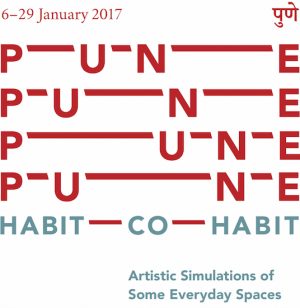Pune Biennale 2017
HABIT-CO-HABIT: Artistic Simulations of Some Everyday Spaces
6-29 January 2017
Curated by Luca Cerizza and Zasha Colah
The title of the flagship exhibition of Pune Biennale 2017 is based on a wordplay between ‘habit’ and ‘cohabit’. By attaching the suffix ‘co’ before ‘habit’, a rather alternate meaning is attained. A habit, or ritual, is literally turned into something else, suggesting a transformation in our own behaviour: we get rid of our habits to start a cohabitation, to live with someone else, to share our living condition with the other, with another.
The exhibition’s subtitle is a reference to the notes and index cards penned by French semiologist Roland Barthes for a series of seminars delivered at the Collège de France from January to May 1977. Barthes chanced upon a word from a religious text to describe his latent fantasy of sociability as ‘idiorrhythmy’, or ‘particular rhythm’, to discuss any community that respects each individual’s personal rhythm.
Removing it from any religious context, Barthes thinks of ‘idiorrhythmy’ as any attempt to reconcile collective life with individual life, and most of the lectures describe forms of collective solitude. Barthes had planned to devote a final lecture to the utopia of ‘living together’ or cohabitation, but this remained unrealised.
HABIT-CO-HABIT ideally takes over Barthes’ project as a possible starting point, inserting his visions into the flesh of the city of Pune, incidentally home to the Osho ashram.
The question of cohabitation is particularly pressing in the context of Pune. An economically leading city in the state of Maharashtra, it is today one of the fastest growing cities in India and, more generally, in the Asia-Pacific region. This rapid growth attracts workers, professionals, students, and migrants from India and elsewhere.
In the context of Doug Saunders’ study on the movement of people from rural to urban areas in the 21st century as constituting the largest migration in history, Pune represents such an ‘arrival city’. As it transforms from a provincial capital into a metropolis, Pune necessarily produces new forms of hybridity and diversity.
Occupying different everyday spaces in the Deccan area, which represented a first wave of modernisation in the development of the city at the end of 19th century, the exhibition explores various forms of cohabitation and social habits to host a reflection on the potentialities, repercussions and consequences of such a movement of people, and of the process of modernisation and urban development. Cohabitation references housing, shelter and the politics of our sleep, as well as the assimilation of people, adaptation of knowledges, and the syncretism of cultural symbols and signs.
HABIT-CO-HABIT presents different simulations of cohabitation in the form of artistic interventions. Each venue has been chosen for its symbolic currency, embodying different forms of cohabitation and social relationships. The artistic interventions will mingle in, relate to, and juxtapose to layers of social, cultural, and artistic signs previously present in those locations. From a museum to a printing press, from a 7th CE archaeological site to a school, from bridges and underpasses to a public garden and street shelters— far from dealing with an ideal, protected artistic environment, HABIT-CO-HABIT will confront the jarring rhythms of everyday life, alternating between spaces of isolation, privacy, social control and community. Rather than inviting audiences to neutral exhibition spaces HABIT-CO-HABIT unfolds within existing communities and readymade audiences. As a ‘diffused’ exhibition, avoiding any singular central venue, it relates instead to the realities of an urban, social and historical cityscape.
HABIT-CO-HABIT will see the participation of local, Indian and international artists. Mostly conceived for this occasion, their productions will spread across 10 locations in the Deccan area of Pune. Stretched along the busy Jungli Maharaj Road, the artistic interventions will create an itinerary of surprising encounters, creating alternative ways to experience everyday spaces.
Some Everyday Spaces
Phule Museum
Pune Municipal Corporation Printing Press
Pataleshwar Caves
Jungli Maharaj Temple
ABIL Underpass
PES (Progressive Education Society) School
Sambhaji Park
Z-bridge and its adjacent ghat
Jungli Maharaj Road and adjoining streets
Artistic simulations by:
Sarnath Banerjee (1972, Calcutta. Lives in Berlin, Germany)
Massimo Bartolini (1962, Cecina. Lives in Cecina, Italy)
Jimmy Chishi (1980, Satakha, Nagaland. Lives in Delhi and Nagaland, India)
Yona Friedman (1923, Budapest. Lives in Paris, France)
Shilpa Gupta (1976, Mumbai. Lives in Mumbai, India)
Sanket Jadia (1991, Surat. Lives in Surat and Delhi, India) in collaboration with Mario D’Souza (1991, Baroda. Lives in Goa and Delhi, India)
Tushar Joag (1966, Mumbai. Lives in Delhi, India)
Marcello Maloberti (1966, Codogno, Italy. Lives in Milan, Italy)
Natak Company (Founded 2009 in Pune. Active in Pune, India)
Amol Patil (1987, Mumbai. Lives in Mumbai, India)
Rupali Patil (1984, Pune. Lives in Pune, India)
Susan Philipsz (1965, Glasgow. Lives in Berlin, Germany)
Smita Rajmane (1988, Wai, Satara. Lives in Delhi, India)
Shubigi Rao (1975, Mumbai. Lives in Singapore)
Tomás Saraceno (1973, San Miguel de Tucumán, Argentina. Lives in Berlin, Germany)
Marinella Senatore (1977, Cava dei Tirreni, Italy. Lives in Paris, France)
The Infinite Library (Daniel Gustav Cramer, 1975, Düsseldorf & Haris Epaminonda, 1980, Nicosia. Live in Berlin, Germany)
U-ra-mi-li (Founded 2011. Iswar Srikumar, 1979, Delhi & Anuskha Meenaskhi, 1980, Mumbai. Live in Chennai, India)
Cathy Wilkes (1966, Belfast. Lives in Glasgow, Scotland)
Et al.


